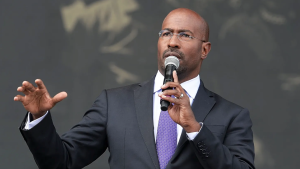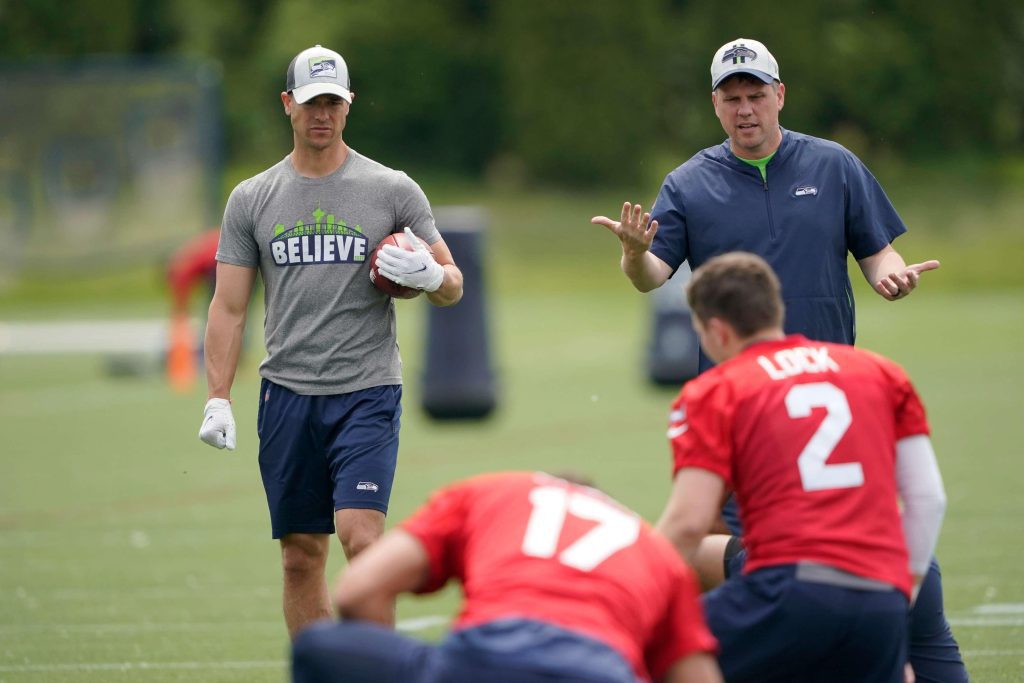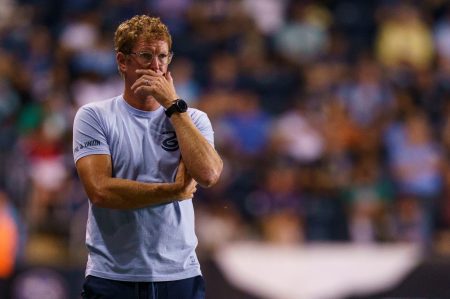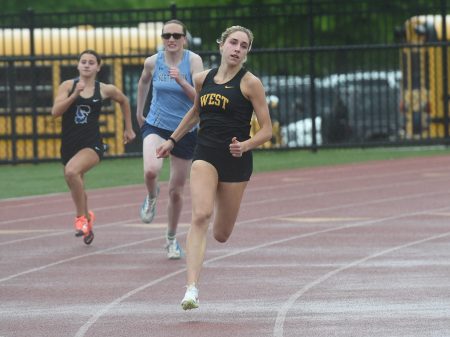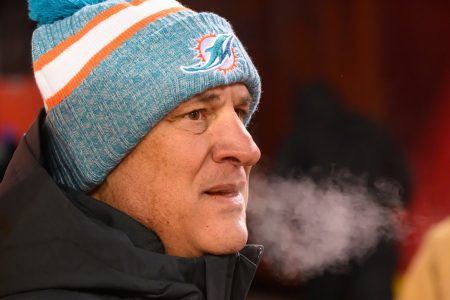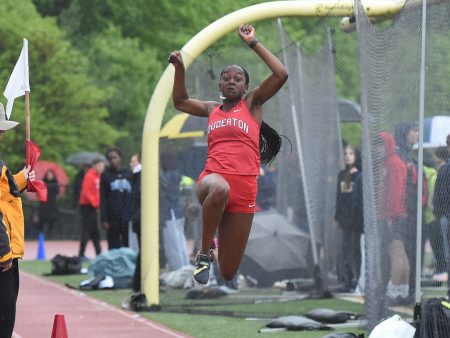Maybe it’s best to start here, late in the fourth quarter of Week 15 with the Seattle Seahawks trailing 17-13 and pinned inside their 10-yard line. The two-minute warning had just passed, right after the Philadelphia Eagles downed a punt at the Seahawks 8.
After scoring a field goal two possessions before, the Seahawks had a chance but faced a tough challenge against a good opponent in the late stages of a crucial game. On the sidelines at Lumen Field, offensive coordinator Shane Waldron approached quarterback Drew Lock — an emergency starter due to Geno Smith’s injury — and started working on a plan.
It was a crucial moment in Seattle for a playoff-contending team in need of a big play on “Monday Night Football.”
The following drive started with an incomplete pass — a strong throw by Lock that was almost intercepted after hitting tight end Noah Fant’s hands and bouncing off. Over the next nine plays, there were a few other almost-disasters. But the series also included five completed passes by Lock, including a big 34-yard throw to DK Metcalf on a third-and-10 play.
Then, when facing another third-and-long from the Eagles 29, Lock identified rookie Jaxon Smith-Njigba in single coverage, had the ideal play call from Waldron and threw a game-winning pass into the end zone with 28 seconds remaining.
Seahawks 20, Eagles 17.
It was a fairly small moment in a disappointing season for the Seahawks, but for everyone involved, it was a triumph in a game-on-the-line situation and represented the resilient, poised and fearless football that Waldron wants his team to play.
Six days later, with Smith back at quarterback, Waldron guided another game-winning touchdown drive that ended in the final minute, this time a grinding, 14-play, 75-yard march that finished with Smith’s 5-yard pass to Colby Parkinson in a 20-17 road win over the Tennessee Titans.
That marked the second time in NFL history — and the first since 1999 — a team had two quarterbacks throw game-winning touchdown passes in the final minute of regulation in consecutive weeks. And it provided additional proof of Waldron’s ability to adjust and prepare his players for success in crucial game moments.
The Chicago Bears are looking to make use of Waldron’s skills and more as he joins them as the new offensive coordinator. That partnership was made official on Tuesday. Waldron, 44, will start the next phase of his football journey at an important time in Bears history.
He will be the creative force behind the team’s quest for a championship while bringing out the best in whichever quarterback(s) the Bears select to lead them into 2024 and beyond.
Waldron will also step into an offensive coordinator’s role at Halas Hall, where — except for Adam Gase — the occupants usually leave on a sour note rather than on a high.
The aim for consistency
Waldron is seen as a rising offensive architect within the league, known for his intelligence, creativity, and strong teaching abilities. His work with Smith in Seattle in 2022 is particularly noteworthy as the once-overlooked quarterback had an outstanding year (4,282 passing yards, 30 TDs), earning Pro Bowl honors and the league’s Comeback Player of the Year award.
Waldron has worked under some of the sport’s coaching greats including Bill Belichick with the New England Patriots from 2008 to 2009, Sean McVay with the Los Angeles Rams from 2017 to 2020, and Pete Carroll for the last three seasons in Seattle.
He was the Rams passing game coordinator for three seasons and Jared Goff’s quarterbacks coach in 2019. He spent one season with Russell Wilson in Seattle before preparing Smith to be a productive starter for a playoff team in 2022.
When the Bears formally introduce Waldron, he will likely discuss three key principles within his offensive philosophy. These include emphasizing the importance of ball security, making a daily investment in fundamentals to stay sharp, and achieving buy-in from the entire group.
Waldron is expected to emphasize his commitment to consistency and the pursuit of balance in his offense. He aims to establish a strong running game while also embracing an attacking mentality when explosive-play opportunities arise.
Just as in those two late comeback victories last month, Waldron undoubtedly wants the identity of his offense to reflect composure, determination, and high-level mental toughness.
As a play caller, he will need to establish a strong connection with his quarterback, striving to consistently bring out the best in whomever that may be.
It is presumed that he will be given the opportunity to provide input as the new bosses at Halas Hall work to solve that riddle in the coming weeks and months. This work will include both pre-draft homework and in-house discussions on the developmental progress of Justin Fields.
Fit process
Like with any coaching hire, it’s easy to initially feel hopeful and envision significant improvements. Waldron’s experience calling plays was definitely a positive for the Bears. For general manager Ryan Poles and coach Matt Eberflus, this removes some of the uncertainty regarding how he might handle those duties in Chicago and what kind of productivity they can expect.
However, Eberflus and Poles hired their last offensive coordinator less than two years ago with Luke Getsy in January 2022, which triggered significant excitement at Halas Hall.
Similar to Waldron, Getsy was lauded as a rising, young offensive coach with high intelligence, proven teaching skills, and impressive creativity. He had been with the Green Bay Packers for six of the previous seven seasons, including three working under Matt LaFleur in a Kyle Shanahan/McVay-style offense. Getsy was endorsed by players and coaches as a strong communicator, steadying leader, and sincere, relatable team builder.
He had been Aaron Rodgers’ quarterbacks coach for MVP seasons in 2020 and 2021 and, while serving as Mike McCarthy’s receivers coach in 2016 and 2017, had been credited by Davante Adams as influential in his breakthrough.
“He’s been on my radar for a while,” Eberflus said after hiring Getsy, later emphasizing his attraction to the timing-based, quick-decision passing attack Getsy was likely to bring.
For the next two seasons, Getsy was seen as a creative football thinker with good teamwork skills and a deep understanding of all the different parts of an offense. However, the Bears, with his guidance, had periods of inconsistency, and the expected progress for Fields never happened as much as the team wanted.
All the good qualities the Bears noticed in Getsy didn't matter much when his offense often struggled.
Fields tried really hard to learn a system that wasn't right for him. Getsy's efforts to fix problems sometimes led Fields away from the plays and ideas he felt most comfortable with.
It became a frustrating situation where the quarterback and the play caller kept adjusting to each other, making it hard for the offense to build momentum, especially in the passing game.
It was a big problem with the fit between the two. Eberflus and Poles need to understand this as they try to help Waldron succeed.
Waldron's experience and ability to adapt should help. But as the Bears possibly make changes at quarterback, making sure the offensive plan matches the players is also really important.
For what it's worth, Waldron's Seahawks had fewer total offense, first downs, touchdowns, third-down conversions, and red-zone efficiency than the Bears this season. They also had one of the worst rushing attacks.
Waldron needs to find ways to make his next offense much stronger. He needs to have solutions and ideas for making the most of his quarterback's skills while also using the strengths of the supporting players.
And when things get tense? When the Bears are in close games? Waldron will be expected to always bring out the best in every player in his offense.
The Bears are optimistic about the future. Ultimately, the results Waldron gets and his ability to help the team's quarterback(s) shine will decide his time in Chicago.
()


